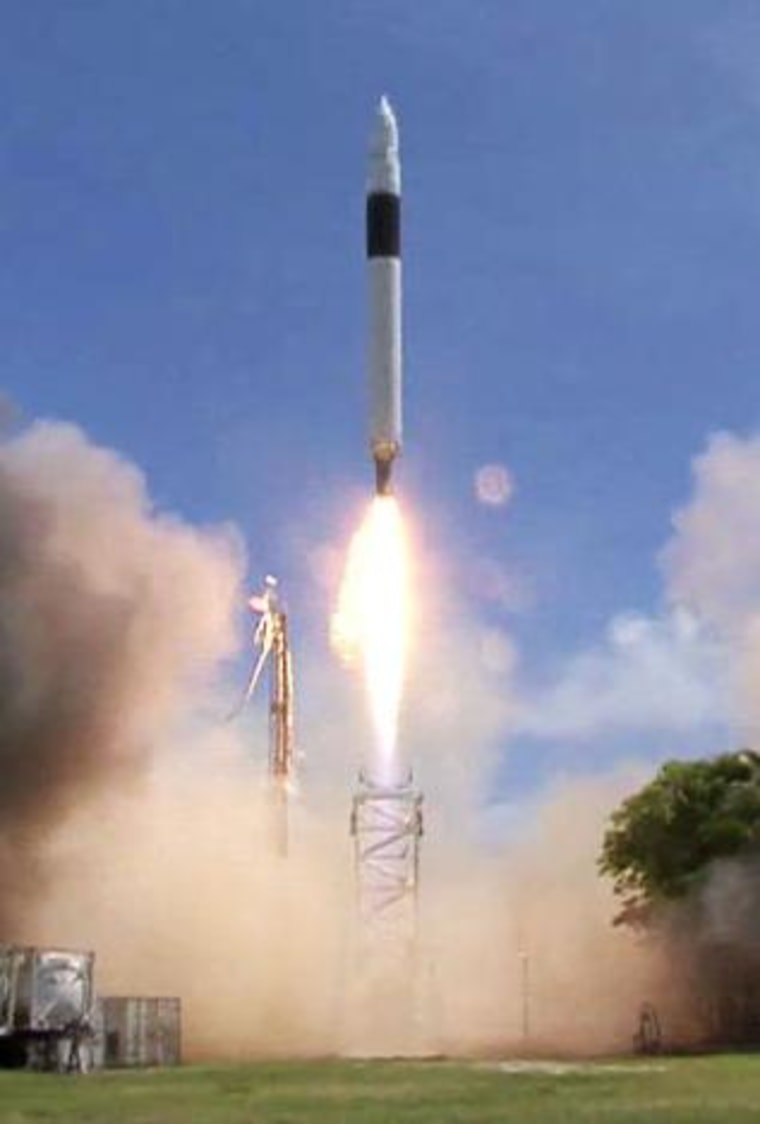After three unsuccessful tries, SpaceX launched its two-stage Falcon 1 rocket into orbit for the first time on Sunday — potentially changing the cost equation for spaceflight.
"That was frickin' awesome," Elon Musk, SpaceX's millionaire founder and chief executive officer, told cheering employees at the six-year-old company's headquarters in Hawthorne, Calif.
"There were a lot of people who thought we couldn't do it ... but, you know, as the saying goes, 'The fourth time's the charm,'" he said after the rocket soared into orbit from its launch pad on Omelek Island, 2,500 miles (4,000 kilometers) southwest of Hawaii in the Pacific Ocean.
The ascent to orbit was broadcast live on the Web, from cameras positioned on the ground as well on the rocket itself.
Success after failure
The launch company's first undisputed success came after an oh-so-close failure on Aug. 2, when the timing was off on the shutdown of the Falcon 1's first-stage engine. Instead of separating cleanly, the first stage bumped into the second stage and knocked it off course. That led to the loss of three satellites, including a NASA prototype solar sail and small experimental satellites from NASA as well as the Defense Department.
The rocket that failed last month also carried cremated remains from more than 200 people who had paid thousands of dollars to have the ashes sent to the final frontier. Among the dearly departed: Mercury astronaut Gordon Cooper as well as James Doohan, who played the engineer Scotty on the original "Star Trek" TV series.
This time around, the 70-foot-tall (21-meter-tall) rocket was carrying only a 364-pound (165-kilogram) dummy payload. After the launch and a planned on-orbit engine restart, the second stage and the attached payload reached its target orbit of 312 by 437 miles (500 by 700 kilometers), which ranges higher than the international space station, Musk said.
Sunday's launch puts SpaceX among a select few U.S. companies that have put launch vehicles successfully into orbit, including the Boeing Co., Lockheed Martin and Orbital Sciences Corp.
"Falcon 1 has made history as the first privately developed launch vehicle to reach orbit from the ground," launch commentator Max Vozoff declared after receiving word that the Falcon 1's second-stage Kestrel engine had cut off successfully.
From dot-com to private space venture
Various factors were behind SpaceX's previous three failures, including a fuel-line leak, a premature engine cutoff and last month's bad timing. Despite the difficulties, Musk persevered, spending more than $100 million of the fortune he gained in the dot-com rush as a founder of the PayPal online payment system.
Slideshow 12 photos
Month in Space: January 2014
After last month's failure, Musk announced that he was taking on outside investment for the first time, a $20 million infusion from San Francisco-based Founders Fund.
The South African native founded SpaceX in 2002 to follow through on his vision of helping humanity become a multiplanet species. In Sunday's remarks to employees, he said the technologies pioneered by Falcon 1 could eventually bring humans to Mars.
"It's just the tip of the iceberg here," Musk said.
The kerosene-fueled Falcon 1 is notable for its price tag: $7.9 million, which is around an order of magnitude lower than the typical cost of an orbital launch. The rocket's first stage is designed to be recovered and reused after each launch, theoretically reducing the expense.
Customers have been lining up already to reserve launch dates for the Falcon 1 and the company's more powerful Falcon 9, which is still under development. During a news briefing, Musk told reporters that he received 500 congratulatory e-mails, including messages from existing and prospective customers.
"They're obviously very excited by what they've seen. ... My phone has been buzzing," he said.
NASA is providing $278 million for the Falcon 9 project under its Commercial Orbital Transportation Services program, or COTS, in hopes that the rocket could help transport cargo to the international space station after the retirement of the space shuttle fleet, which is currently scheduled for 2010.
The first Falcon 9 is due to be delivered to Cape Canaveral, Fla., around the end of this year, in preparation for a launch next year. Musk said SpaceX was "on track" to meet that schedule.
In the wake of Sunday's launch, SpaceX received a wave of congratulations not only from customers, but also from the advocates of lower-cost, entrepreneurial approaches to spaceflight. Space consultant Charles Lurio said Falcon 1's flight "can be a bright glint of the new dawn for the Space Age that's just over the horizon."
That sentiment was echoed by the nonprofit National Space Society.
"Private ventures such as SpaceX offer the promise of lower-cost launch, opening space to new ventures and people while enabling NASA to explore beyond," the society said in a statement released after launch. "This hard-won success demonstrates again that space can in fact be accessed by small teams and companies, and confirms the promise of a new age in space."

